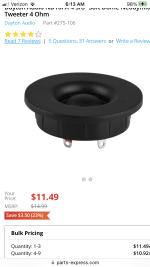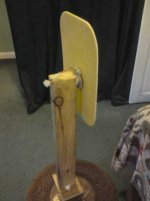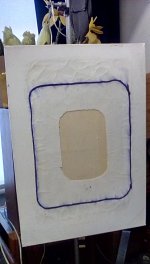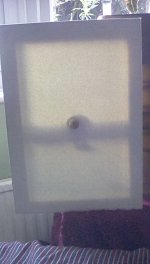They can be heard on youtube.Have you ever heard Bertagni speaker in person?
Makes sens. Intermodulation occurs in a system when 2 (or more) signals of different frequencies enter and are combined by the non linearity then produce new signals which frequencies are combination of the input frequencies. You can refer back to the posts about contamination spectrum some months ago or any intermodulation test in power amp.Those are for WFS applications, so using multiple exciters arranged in a line to play different signals.
Quite interesting, but cannot find anything that would apply to using a cluster with the same signal.
Have you even read his patents? He talks about "intermodulation between the low frequency and high frequency regions of the speaker" not intermodulation between two exciters next to each other playing back the same signal. If you for some reason want to do that kind of outdated design, there might be some useful info in his patents.
I’m turning to page 20 and while intending to continue reading and eventually catch up I have two questions for anyone interested in answering.
First is thoughts on placing a tiny neo tweeter like this with very wide dispersion either in the middle of the exciter, if there’s a void, or just somewhere close. To clarify, press fit the tweeter directly over where the exciter is mounted. From what I’ve read and watched so far, the treble problems, if inherent in a material type, doesn’t begin to present until 10khz and higher, generally speaking. Tiny neo might allow the use of a material more suitable of lower frequency reproduction?
Small dml panels in a f.a.s.t arrangement? I’ve got a little ~10”x14” space in my living room shelves that would appear a great place to hang a small panel of proper size ratio. I’m just about to wrap up a bookshelf build I’ve been working hard on for the shelves but maybe some stereo dml panels would allow a 2ch front for movies which would allow more freedom in listening position for me and my girlfriend?
Even if for nothing more than another set of speakers to a/b I wonder if a panel suspended from the top shelf with a small-ish subwoofer on each side would be cool setup. Just like with the bookshelves I could slide the shelves forward and away from the walls when critically listening.

First is thoughts on placing a tiny neo tweeter like this with very wide dispersion either in the middle of the exciter, if there’s a void, or just somewhere close. To clarify, press fit the tweeter directly over where the exciter is mounted. From what I’ve read and watched so far, the treble problems, if inherent in a material type, doesn’t begin to present until 10khz and higher, generally speaking. Tiny neo might allow the use of a material more suitable of lower frequency reproduction?
Small dml panels in a f.a.s.t arrangement? I’ve got a little ~10”x14” space in my living room shelves that would appear a great place to hang a small panel of proper size ratio. I’m just about to wrap up a bookshelf build I’ve been working hard on for the shelves but maybe some stereo dml panels would allow a 2ch front for movies which would allow more freedom in listening position for me and my girlfriend?
Even if for nothing more than another set of speakers to a/b I wonder if a panel suspended from the top shelf with a small-ish subwoofer on each side would be cool setup. Just like with the bookshelves I could slide the shelves forward and away from the walls when critically listening.
Attachments
Thank you Eric for those extremely interesting measurements.The videos below repeat the previous tests, but show the results from 1k to 20k, using an 8k FFT with 1/48 smoothing and no averaging.
Eric
We can see what was reported here several times which is the high frequencies don't travel a lot. They are quite quickly absorbed. It is like if the emitting area decreases when the frequency increases. This might explain the loss of level in HF at distance.
This is mentioned in the thesis of post #9773 where the material was selected with a high enough damping to create separated enough sources to allow a sound synthesis.
What we see in the videos with 2 exciters is a reduction of level between the 2 exciters even when there are closed. If we had a 2D view of the plate, in HF we would see probably for a given frequency something like 2 islands centered on the exciters.
So in my view, the 2 exciters operate as only one source up to a certain frequency from which 2 localized sources are more and more visible. When the 2 exciters operate as one, other areas of the panel are also emitting due to the waves traveling up to the edges and coming back. When the 2 exciters operate separately, the over all level at distance is probably also decreasing. In this situation are there areas apart the exciters also emitting? To check.
Christian
Hello!
I was planning to try and make a pair of DMLs. I've done a fair bit of research and read a good bit of this thread but I'm pretty new to audio generally so am finding it a lot to get my head around. The basic plan I've settled on is using a couple of cheap stretch canvases to make my speakers, but I have a few questions:
I was planning to try and make a pair of DMLs. I've done a fair bit of research and read a good bit of this thread but I'm pretty new to audio generally so am finding it a lot to get my head around. The basic plan I've settled on is using a couple of cheap stretch canvases to make my speakers, but I have a few questions:
- What size and shape of canvas should be used? For DMLs made using materials such as XPS it seems to be common for them to be close to square, however all the examples of canvas DMLs I've seen have been more rectangular. Is there a reason for this?
- I think I've settled on using the DAEX25 exciter, both because of price and because they are 8ohms which means they are above the minimum impedance of the AV receiver I plan to use them with. I've seen some people cut off the legs from these exciters, should I do this?
- What size and shape should the piece of balsa between the exciter and the canvas be? I've seen both small circular pieces and larger rectangular pieces being used, does it matter?
- Can I mount the back of spine directly to a wall, and should I have some sort of damping material (melamine sponges?) between the wall and the canvas?
- It seems like with the canvas panels the exciter is usually mounted at the centre instead of the 2/5 3/5 position. Why?
- I plan on eventually using these panels to setup a 5.1 system. In terms of EQing the speakers, I was thinking of connecting them all to my AV receiver and then that to my PC, and then using a calibration mic and room eq wizard. Does this make sense? Maybe this is a dumb question, but is doing this any different from EQing the panels individually?
The tweeter should not touch the diaphragm material of choice as the tweeter will act as a weight, damping the panel and reducing certain frequencies. Instead it should be mounted on to a frame.I’m turning to page 20 and while intending to continue reading and eventually catch up I have two questions for anyone interested in answering.
First is thoughts on placing a tiny neo tweeter like this with very wide dispersion either in the middle of the exciter, if there’s a void, or just somewhere close. To clarify, press fit the tweeter directly over where the exciter is mounted. From what I’ve read and watched so far, the treble problems, if inherent in a material type, doesn’t begin to present until 10khz and higher, generally speaking. Tiny neo might allow the use of a material more suitable of lower frequency reproduction?
Small dml panels in a f.a.s.t arrangement? I’ve got a little ~10”x14” space in my living room shelves that would appear a great place to hang a small panel of proper size ratio. I’m just about to wrap up a bookshelf build I’ve been working hard on for the shelves but maybe some stereo dml panels would allow a 2ch front for movies which would allow more freedom in listening position for me and my girlfriend?
Even if for nothing more than another set of speakers to a/b I wonder if a panel suspended from the top shelf with a small-ish subwoofer on each side would be cool setup. Just like with the bookshelves I could slide the shelves forward and away from the walls when critically listening.
View attachment 1158293
If this is true (which I am not doubting), wouldn't it be a good idea to boost the treble of the signal? I am a neophyte, and have never studied the mechanics of audio, My masters was in human relations.We can see what was reported here several times which is the high frequencies don't travel a lot. They are quite quickly absorbed. It is like if the emitting area decreases when the frequency increases. This might explain the loss of level in HF at distance.
Even a couple gram neo on a board with considerably more weight? I’ve seen some adding small amounts of weight to nodes on the board, maybe on a node?The tweeter should not touch the diaphragm material of choice as the tweeter will act as a weight, damping the panel and reducing certain frequencies. Instead it should be mounted on to a frame.
Its not about the diaphragms weight, but the weight attached to the diaphragm that will block/interfere with vibrations that spread across the panel to the edges.
Its no different then a conventional cone driver, you wouldnt add any weight to the cone diaphragm instead you mount on the frame like in this picture so that the tweeter does not touch the cone diaphragm.

Its no different then a conventional cone driver, you wouldnt add any weight to the cone diaphragm instead you mount on the frame like in this picture so that the tweeter does not touch the cone diaphragm.
Lawnboy.
I do like those lamp shelves 😁 they look perfect for mounting a panel without affecting or changing the room.
You could even still use the shelf behind with the two jars.
If a light panel material was use this type of mounting could be used , and just placed on the shelf ,or even moved around.
As long as the shelves do not rattle and items vibrate 😁
Or hang a canvas panel with a painting on ?
It will depends on the panel type you choose to use.
The panel will already have a wide angle dispersion ,far better than any dome tweeter.
I would use the cheapest option first just to experiment first, something like 2mm corrugated cardboard for instance or ply .
It would sound great for surround and stereo music, a whole new experience.
I wonder if I can get those shelves in the UK 😀
Steve.
I do like those lamp shelves 😁 they look perfect for mounting a panel without affecting or changing the room.
You could even still use the shelf behind with the two jars.
If a light panel material was use this type of mounting could be used , and just placed on the shelf ,or even moved around.
As long as the shelves do not rattle and items vibrate 😁
Or hang a canvas panel with a painting on ?
It will depends on the panel type you choose to use.
The panel will already have a wide angle dispersion ,far better than any dome tweeter.
I would use the cheapest option first just to experiment first, something like 2mm corrugated cardboard for instance or ply .
It would sound great for surround and stereo music, a whole new experience.
I wonder if I can get those shelves in the UK 😀
Steve.
Attachments
I’ve also considered mounting the panels like yours, exciter on a fixed surface, but instead of a stand, on the wall behind the shelves. Maybe small balsa or bamboo panels would not be too hindered by being only a few inches off a wall? I could also get away with using something closer to a 18”x24” if on the wall. I’ve seen smaller metal stands that could easily hold a medium panel and allow some movement in the mount if that’s desirable with things of this nature.

The ideal situation would be to mount a ~10”x14” panel on the back of the shelves and just moving the shelves out for critical listening as necessary. This would allow a happy girlfriend because there’s nothing looking goofy blocking the front of the shelves. My home builds are geared towards getting the most performance from the smallest form factor, life is just easier not having to fuss with her over my hifi hobby integrating into our living space. These are from amazon, very efficient use of space in a modest sized townhome.


What’s the lower limit on response on your small panels?Lawnboy.
I do like those lamp shelves 😁 they look perfect for mounting a panel without affecting or changing the room.
You could even still use the shelf behind with the two jars.
If a light panel material was use this type of mounting could be used , and just placed on the shelf ,or even moved around.
As long as the shelves do not rattle and items vibrate 😁
Or hang a canvas panel with a painting on ?
It will depends on the panel type you choose to use.
The panel will already have a wide angle dispersion ,far better than any dome tweeter.
I would use the cheapest option first just to experiment first, something like 2mm corrugated cardboard for instance or ply .
It would sound great for surround and stereo music, a whole new experience.
I wonder if I can get those shelves in the UK 😀
Steve.
Hi Christian .
how far the hf travels depends on the panel materials.
my ply panels for instance , the hf will reach 20k all the way to the far corners , but 70 grade EPS will only be about 10k at the edges.
I can now measure this in real time now I am on YouTube , if you wish ?
It seems so much easier.
Steve
how far the hf travels depends on the panel materials.
my ply panels for instance , the hf will reach 20k all the way to the far corners , but 70 grade EPS will only be about 10k at the edges.
I can now measure this in real time now I am on YouTube , if you wish ?
It seems so much easier.
Steve
Lawnboy,
The ideal DML panel material is light and stiff, as that combination provides high efficiency. But you might be surprised to learn that solid sheets of carbon fiber are actually on the heavy side, and will have relatively poor efficiency. Fiberglass, due to it's higher density and lower stiffness would be even less ideal.
On the other hand, sandwich composites with CF or FG skins on a lightweight core, like nomex honeycomb or balsa, are much better, mainly because they are much lighter. This is the kind of panel construction found on Tectonic and Goebel DMLs. Unfortunately, however, it's pretty hard to find commercially available sandwich composites of just the right thicknesses of core and skin layers, usually, they are too thick and too stiff, as they are intended for structural applications, and not DML panels.
If you have experience with composites, however, you might be able to build yourself a truly great panel!
Eric
The ideal DML panel material is light and stiff, as that combination provides high efficiency. But you might be surprised to learn that solid sheets of carbon fiber are actually on the heavy side, and will have relatively poor efficiency. Fiberglass, due to it's higher density and lower stiffness would be even less ideal.
On the other hand, sandwich composites with CF or FG skins on a lightweight core, like nomex honeycomb or balsa, are much better, mainly because they are much lighter. This is the kind of panel construction found on Tectonic and Goebel DMLs. Unfortunately, however, it's pretty hard to find commercially available sandwich composites of just the right thicknesses of core and skin layers, usually, they are too thick and too stiff, as they are intended for structural applications, and not DML panels.
If you have experience with composites, however, you might be able to build yourself a truly great panel!
Eric
Lawnboy.
The first two pictures are of a canvas test panel, it is 30cm x 42cm.
This panel goes down to 40hz but will not be happy playing heavy bass.
I would probably xo this at something like 90hz to play heavy rock or film soundtracks, and to increase power handling.
The third picture is of a 5mm XPS panel coated in epoxy , I could cut this down to whatever size you would like and measure it for you if you wished.
Tech ingredients have a video on strengthening EPS with fibre glass but I preferred to keep the weight down with only a thin coat of epoxy.
The forth picture is of a canvas panel without the ply panel just the canvas, but this only goes down to about 300hz or so , can't remember exactly, but can measure this too if wanted ?
Steve.
The first two pictures are of a canvas test panel, it is 30cm x 42cm.
This panel goes down to 40hz but will not be happy playing heavy bass.
I would probably xo this at something like 90hz to play heavy rock or film soundtracks, and to increase power handling.
The third picture is of a 5mm XPS panel coated in epoxy , I could cut this down to whatever size you would like and measure it for you if you wished.
Tech ingredients have a video on strengthening EPS with fibre glass but I preferred to keep the weight down with only a thin coat of epoxy.
The forth picture is of a canvas panel without the ply panel just the canvas, but this only goes down to about 300hz or so , can't remember exactly, but can measure this too if wanted ?
Steve.
Attachments
Lawnboy.Jmproject.
My point was that having the panel parallel to the wall is the problem.
Moving the panel forwards a few inches and still parallel to the wall is still the problem.
You can hold the panel on the wall and pull out one side of the panel only, you can then hear the difference without the parallel compression and cancellations.
If you hinged the side of the panel that will stay on the wall, you can fold them back if not using them, To save space.
How far you want to pull them out is up to you.
Steve.
I posted this a short while ago ,I hope this answers your wall questions.
Steve.
- Home
- Loudspeakers
- Full Range
- A Study of DMLs as a Full Range Speaker





